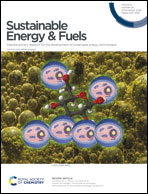Polysulfide shuttle mitigation through a tailored separator for critical temperature energy-dense lithium–sulfur batteries†
Abstract
Sulfur is one of the promising next-generation cathodes owing to its light weight, abundance, cost, and above all extremely high theoretical capacity. However, the chemistry suffers from critical issues viz., poor sulfur conductivity, polysulfide shuttling, and lithium dentritic growth. Here, through the use of a tailored separator, comprising graphene–polydopamine coated on a standard Celgard polypropylene separator, all the issues were tackled simultaneously. The functionalized separator acted as a barrier for polysulfide shuttling by adsorbing them preferably due to their favorable interactions with functional groups of polydopamine on the surface and outperformed the pristine separator. At −25, 0, 25, 40, and 50 °C, the cells yielded about 170, 350, 580, 360, and 550 mA h g−1 capacity, respectively. The system delivered 100 cycles at 50 °C followed by 300 cycles at 40 °C. The capacity retention of 95% at 0.5C was reported after being exposed to high rates of 3C and 4C. A similar stable performance was observed with single-layered pouch cells. This high-performance Li–S batteries can be valuable to a variety of applications such as defense, transportation, and space explorations, where drastic conditions affect the battery functionalities.



 Please wait while we load your content...
Please wait while we load your content...